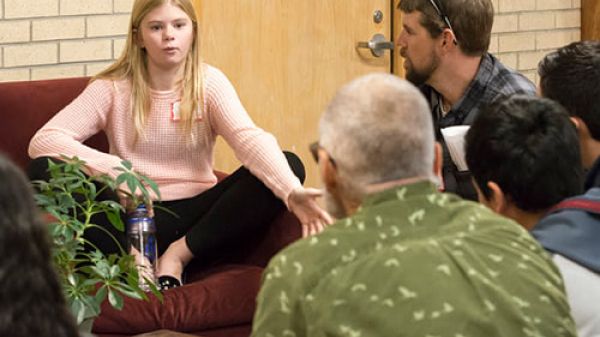Earth Education Expands to Teach Active Participation in Public Life

By Sarah R. Johnson, MAEd, Wild Rose Education
Originally published at InTeGrate Science Education Resource Center and Wild Rose Ruminations
As the world continues to be bombarded by wicked issues, neuroscience research continues to expand and inform the field of teaching and learning. We scientifically know how to teach learners how to change their perspective to be better observers, rewire neural pathways and, think about problems in systematic expansive ways. Combining this knowledge with the creative ingenuity of our youth, there is ample real hope and opportunity for our future; a future of collective wisdom, a systems approach, and inclusion of all types of knowledge and ever expanding understanding of how the natural world works. Earth Education leaders (administrators, practitioners, and researchers) have a profound responsibility to include the best of what is known about teaching and learning, Earth Science, and community engagement into their every day professions to ensure opportunities to foster real world change for learners and their communities.
Learners at every stage in life need not only learn peer-reviewed sound content knowledge of earth science, but also how to utilize their knowledge leveraging their previous experiences and unique perspectives. The Earth Education community has the opportunity to teach students to apply their learning through the process of investigating learners’ authentic concerns about environmental issues, and then creating evidence-based calls to action to share with decision and policy makers. Earth Education as an academic field, has a tremendous opportunity to not only teach geology, hydrology, geomorphology, etc., yet to apply those sciences into practice within a community context. This context is the ‘so what’ of the learning.
The Youth Water Leadership ProgramTM a program designed in 2017 by Wild Rose Education works to exemplify and model a style of learning that is student centered and encourage the learner to apply the technical water, river, and climate change science and policy learned in the field and classroom to participating in public life. Students grades 7-16 from the local rural watershed are invited to investigate their personal water, river, or climate change concerns and form a thoughtful evidence-based call-to-action to present at the annual Healthy Rivers Youth Water Summit where elected officials and policy makers attend as listeners. The Summit is an empowering and inspiring learning experience for all who participate.
Through the process of investigating their concerns months prior to the Healthy Rivers Youth Water Summit, students are given the chance to dig deep into something they are genuinely passionate about. They have time to understand the complexities of issues, recognize stakeholders’ perspectives, and strategize how to best communicate their call-to-action during the Summit. Traditional learning environments can typically focus on the quantity of content that can be fire-hosed on students and not on the process of learning how to thoroughly investigate issues the students are truly concerned about.
The Youth Water Leadership Program is a programmatic ‘umbrella’ so to speak that currently includes many sub-programs:
- co-designing a university level multi-day event with similar goals to the Healthy Rivers Youth Water Summit,
- youth community action project educator professional development workshop,
- multi-age student leader team who plan and host the Summit,
- and other opportunistic unique learning experiences that help students prepare to participate in the Summit (e.g. Mobile Earth and Space Observatory water week visit, CIRES Lens onClimate Change filmmaking summer program, Let’s Talk Rivers deliberative forum naming and framing internship).
Earth Education has the potential to powerfully foster sustainable communities through so many possible programs. The Youth Leadership Program is one program that could be scaled and deployed in various places and could be expanded regionally, statewide, and beyond with a thoughtful strategy, dedicated sponsors, and strong partnerships. It has been successful in a rural area with only 10 schools, 20 financial sponsors, and more than 24 programmatic partners involved so far. There is room for creative and expanded program design and implementation; anything is possible.
One of the most insightful learnings from the design and implementation of the Youth Water Leadership Program is the need for teachers to have substantial support and coaching. Educators do not typically have the necessary toolbox of strategies to facilitate students in investigating environmental issues of personal concern. There is significant need for educators to not only have professional development learning opportunities, but also the support of their peers administrators to allow students to take a deep dive into a topic that sometimes neither the teacher nor the student have much previous knowledge about. This teacher-student partnership of genuinely learning together can be rather exciting and quite effective. This type of learning process offers students (and educators) transferable skills needed to participate in public life, contribute to society, and make well-informed decisions ultimately creating sustainable communities grounded in sound science.
Earth Educators have the heavy task of teaching students about one of the most wicked problems in human history: climate change. If taught through a lens of teaching learners how to be systems thinkers, how to investigate environmental issues weighing the opportunities and trade-offs, how to listen to and respect diverse perspectives, how to communicate their evidence based opinions, and how to participate in and contribute to public life, we as educators will have fostered a future of sustainable communities for all.

Comments
It's both a challenging and opportunistic time for Earth educators. Here's to the application of knowledge and continued success of the Youth Water Leadership Program at Wildrose plus continued growth of this philosophy! Thanks Sarah, and good to meet you in MN recently. Teri
Sarah,
Thanks for this piece. I love where you are going with this program. I think we are seeing across the spectrum that young people have the potential to influence the choices made by policy and/or decision makers at all levels. And, while the work of amazing young people like Greta Thunberg inspires all of us we shouldn't forget that it is the day-to-day work of engaging with policy makers in our communities (rural or urban, small or large) is equally as important to addressing issues like climate change.
Congratulations on a great project!
Vince
It was brought to my attention that "Earth Education" may be misused here. I want to clarify that I originally wrote this piece for the Earth Education for Sustainable Societies workshop (https://serc.carleton.edu/integrate/workshops/sust_societies/overview.h…). I have been a student of Steve van Matre's Earth Education work for many years and find it to be insightful. 'Earth Education' is a broad term that we need as many educators as possible to embrace and to do the work well. Keep up the good work all!
Thanks Cam for your email below.
In response to this email from Cam Mackenzie:
Cam Mackenzie
Sat, Sep 28, 3:05 AM (2 days ago)
to me
Hi Sarah,
I’ve just read your Blog via NAAEE and just wondered about the use of the term Earth Education/Educator. I assume you’re aware of the Institute for Earth Education http://www.ieetree.org/ieetree_html5.html which has been around since the 1970s.
I believe a more appropriate term that reflects what your Blog was referring to could be Earth Science Educators. Just a thought.
Kind regards
Cam Mackenzie
Vice President
Australian Association for Environmental Education
Principal
Amaroo Environmental Education Centre
11 Ascot Street
Newtown
Toowoomba QLD
Australia 4350
H & F +61 7 4634 5252
M +61 434 079 620
E: cam.mackenzie@bigpond.com